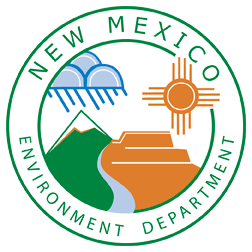When groundwater contamination occurs, typically the entity responsible for the contamination (often referred to as the “responsible party”) must clean up the contamination with NMED oversight.
Clean-up through State Cleanup Program
Our State Cleanup Program administers portions of the New Mexico Ground and Surface Water Protection Regulations, 20.6.2 NMAC, that require the clean-up of contaminated soil, soil vapor and groundwater to protect human health and the environment. The regulations require corrective actions to mitigate any damage caused by an unauthorized discharge as well as investigation and abatement of subsurface contamination in order to meet groundwater standards.
Responsible persons have the option of cleaning up a site under voluntary abatement if they have not yet been notified of an abatement plan requirement. Responsible persons or prospective purchasers may also clean up a site under the Voluntary Remediation Program prior to being notified of an abatement plan requirement.
20.6.2.1203 NMAC Unauthorized Discharge (Spill) Clean-up
In the event of an current or historical unauthorized discharge (spill) of oil or other water contaminant, the responsible party is required to report the incident and take corrective actions to clean up the damage caused. Where ground water is impacted or threatened, the State Cleanup Program often takes the lead in approving and overseeing the corrective actions required of the responsible party pursuant to 20.6.2.1203 NMAC. Please report any unauthorized discharges to NMED by submitting an incident report here
20.6.2.4000-4115 NMAC Prevention and Abatement of Water Pollution
If a responsible party is required to abate contamination pursuant to 20.6.2.4000-4115 NMAC, the responsible party must design and implement Stage 1 and Stage 2 Abatement Plans, following NMED approval and after a public notice and participation process. Abatement plans must address pollution in the vadose zone and in groundwater with the goal of attaining groundwater quality standards and applicable screening levels.
The first stage of the abatement process consists of a site investigation to provide the data necessary to select and design an effective abatement option. The investigation typically includes a review of the site’s history, characterization of the hydrologic and geologic conditions, environmental sampling, and a monitoring program. The purpose of the Stage 2 abatement plan is to select and design an abatement option that will result in attainment of abatement standards. Upon successful completion of the abatement, NMED provides written notification that the abatement plan is being terminated and that no further action is required.
Clean-up through Voluntary Remediation Program
New Mexico’s Voluntary Remediation Program (VRP) provides incentives for the voluntary remediation of contaminated properties and encourages their redevelopment. Participants who successfully complete the program receive site closure documentation from NMED and liability protection for lenders and future purchasers.
To learn more, visit NMED’s VRP website here
Clean-up through Brownfield Program
A brownfield is a property whose redevelopment is complicated by the presence of contamination or perceived contamination. Examples include old gas stations, vacant motels, former industrial sites or abandoned dumps.
Cleaning up and reinvesting in these properties can restore the environment, reduce health risks, eliminate blight, revitalize downtowns, create jobs, increase local tax bases, and create a sense of community pride. View our program brochure for more information about the resources available for brownfields redevelopment.
To learn more, visit NMED’s Brownfield Website here.
Clean-up through Superfund
Thousands of contaminated sites exist nationally due to hazardous waste being dumped, left out in the open, or otherwise improperly managed. These sites include manufacturing facilities, processing plants, landfills and mining sites that pose an viable threat to human health and the environment if left unabated. In response to these threats, the United States Congress passed the Comprehensive Environmental Response, Compensation and Liability Act (CERCLA)in 1980. CERCLA is informally called Superfund. It allows EPA in conjunction with state environmental agencies like NMED to clean up contaminated sites. In New Mexico, cleanup of superfund sites is overseen by NMED’s Superfund Oversight Section.
Neglected Contamination Sites
For more information on Neglected Contamination Sites, please visit the Neglected Contamination Sites webpage.
Clean-up Resources and Site Lists
Clean-up Resources
- SEMS (CERCLIS) – Superfund Enterprise Management System (EPA)
- ATSDR – Agency for Toxic Substances and Disease Registry (CDC)
- IRIS – Integrated Risk Information System (EPA)
- ENVIROFACTS – Search multiple Federal environmental database
- Remediation Technologies for Cleaning Up Contaminated Sites (EPA)
- 2021 NMED Risk Assessment Guidance for Site Investigations and Remediation (November 2021)
- Delegation of Responsibilities to NMED and Oil Conservation Division
- Consultant List, Firms providing assistance with wastewater and remediation
- Laboratory List, Laboratories capable of testing environmental media

